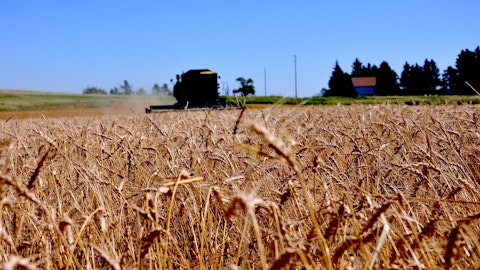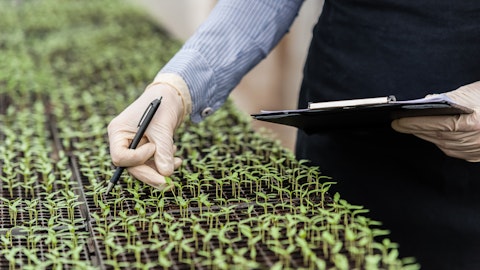Bunge Limited (NYSE:BG) Q4 2022 Earnings Call Transcript February 8, 2023
Operator: Good morning, and welcome to the Bunge Fourth Quarter 2022 Earnings Release and Conference Call. All participants will be in listen-only mode . Please note this event is being recorded. I would now like to turn the conference over to Ruth Ann Wisener, Vice President of Investor Relations. Please go ahead.
Ruth Ann Wisener: Thank you, Drew , and thank you for joining us this morning for our fourth quarter earnings call. Before we get started, I want to let you know that we have slides to accompany our discussion. These can be found in the Investors section of our website at bunge.com under Events and Presentations. Reconciliations of non-GAAP measures to the most directly comparable GAAP financial measure are posted on our website as well. I’d like to direct you to Slide two and remind you that today’s presentation includes forward-looking statements that reflect Bunge’s current view with respect to future events, financial performance and industry conditions. These forward-looking statements are subject to various risks and uncertainties.
Bunge has provided additional information in its reports on file with the SEC concerning factors that could cause actual results to differ materially from those contained in this presentation, and we encourage you to review these factors. On the call this morning are Greg Heckman, Bunge’s Chief Executive Officer; and John Neppl, Chief Financial Officer. I’ll now turn the call over to Greg.
Greg Heckman: Thank you, Ruth Ann, and good morning, everyone. We capped off another exceptional year for Bunge with a solid fourth quarter performance. Our continued strong results speak to the flexibility of our platform and team, which, as I’ve said before, are built to adjust and even excel in volatile times. In this year that had more than its share of ups and downs, our team proved their ability to help our customers, both farmers and end users globally, manage risks and navigate food security issues against the backdrop of regional conflict, weather impacts and many other factors. I want to thank the team for their continued dedication to strong execution, which allowed us to build on our positive momentum and deliver our fourth consecutive year of earnings growth.
We’re focused on our mission and it shows in our financial results. Looking at the fourth quarter numbers. Adjusted core segment EBIT came in above last year’s results, largely driven by strong performance across all regions in Refined and Specialty Oils. John will go into our results in more detail, but I want to note our performance reflects our rigorous and disciplined approach to the business, including our focus on operating costs and the returns on capital we’re investing. Looking ahead to 2023, we expect the market environment to be similar to 2022, with many of the same drivers still in place, that includes a globally tight crop supply, strong demand for our core protein meal and vegetable oil products and the continued impact to global trade of commodity price volatility and supply chain disruptions.
We also expect to see global demand for feedstocks and related services for renewable fuels continue to grow. Based on what we see in the market and the forward curves today, we expect full year adjusted EPS of at least $11 per share for 2023. And with that, I’ll hand the call over to John to walk through the results and the outlook in more detail.
John Neppl : Thanks, Greg, and good morning, everyone. Let’s turn to the earnings highlights on Slide five. Our reported fourth quarter earnings per share was $2.21 compared to $1.52 in the fourth quarter of 2021. Our reported results included a negative mark-to-market timing difference of $0.56 per share and a negative impact of $0.47 per share related to onetime items. Adjusted EPS was $3.24 in the fourth quarter versus $3.49 in the prior year. Full year results for 2022 were $10.51 versus $13.64 in 2021. Adjusted full year EPS was $13.91 versus $12.93 in the prior year, an increase of nearly $1 per share. Adjusted core segment earnings before interest and taxes, or EBIT, was $804 million in the quarter versus $766 million last year.
Agribusiness finished with an outstanding year with another strong quarter that was in line with last year. In processing, results were primarily driven by North America, which benefited from the combination of large soy and canola crops and strong meal and oil demand. Partially offsetting this strong performance were lower results in Europe and South America. Europe was negatively impacted by higher energy costs and lower volume that included increased planned downtime and the idling of our operations in Ukraine. In South America, tight bean supplies reduced margins. In merchandising, higher results in global grains were more than offset by lower results in global oils marketing, which had a particularly strong prior year. Refined and Specialty Oils finished another record year with strong fourth quarter results of $222 million, up $68 million compared to last year.
All regions performed well in the fourth quarter, benefiting from strong food and renewable fuel demand with notable year-over-year improvements in Europe, Asia and South America. In Milling, the loss in the quarter was primarily driven by lower origination volume and high supply chain costs, reflecting the small Argentine wheat crop that negatively impacted our merchandising operations. Results in the prior year benefited from contributions from our Mexico wheat mills, which we sold in the third quarter of 2022. Corporate and Other was in line with last year. A decrease in corporate expense is primarily related to the timing of performance-based compensation accruals, was offset by results in our captive insurance program and lower results in Bunge Ventures.
Improved results in our noncore Sugar & Bioenergy joint venture were primarily driven by higher sugar prices, which more than offset lower ethanol margins. For the quarter, reported income tax expense was $131 million compared to $64 million for the prior year. The increase was due to higher pretax income and a year-to-date adjustment in actual geographic earnings mix. Adjusting for notable items and mark-to-market timing, the effective tax rate for the full year was 17% compared to approximately 16% for the prior year. Net interest expense of $76 million in the quarter was up compared to last year due to higher interest rates, partially offset by lower average debt levels. Also impacting the quarter were foreign currency borrowings in certain countries where interest rates were high.
However, the incrementally higher borrowing costs were fully offset with currency hedges reported in gross margin. Let’s turn to Slide six, where you can see our positive EPS and EBIT trends adjusted for notable items and timing differences over the past five years. This not only demonstrates the power of our global asset networking capabilities, but also the continued outstanding performance by our team. Each of these years brought a different set of rapidly changing circumstances and the team successfully navigated through them, while also executing on numerous company initiatives. As shown on Slide seven, our full year addressable SG&A increased modestly year-over-year, reflecting a resumption of more normal business activities as well as increasing investments to strengthen our capabilities and to drive growth, particularly in technology.

Photo by Anna Pelzer on Unsplash
We expect higher SG&A in 2023 related to these initiatives, which we have considered in our outlook. Slide eight details our capital allocation of the approximately $2.4 billion of adjusted funds from operations that we generated in 2022. After allocating $306 million to sustaining CapEx, which includes maintenance, environmental, health and safety and $8 million to preferred dividends on shares now converted to common equity, we had approximately $2 billion of discretionary cash flow available. Of this amount, we paid $341 million in common dividends, invested $249 million in growth and productivity CapEx and repurchased $200 million of common shares. The approximately $1.3 billion of retained cash flow was invested in additional working capital and toward reducing debt.
As we laid out in our earnings growth framework in the second quarter of last year, we expect to repurchase about $250 million of stock each year, but actual amounts could vary. During 2023, we expect to deplete the remaining $300 million of our existing $500 million program which was announced in October 2021 and approve an additional share repurchase program. Moving to Slide nine. We finished 2022 with a total CapEx spend of $555 million, which was about $50 million lower than we expected in our Q3 forecast. The primary drivers of the reduction were supply chain delays on long lead time equipment as well as additional project planning time, as we look more closely for opportunities to offset inflationary pressures. We expect continued delays in 2023, which are reflected in our current outlook.
Lead times for simpler equipment and parts are showing signs of normalizing. However, due to increased project costs, we are reassessing the scope and timing of certain discretionary investments. As shown on Slide 10, at year-end, readily marketable inventories, or RMI, exceeded our net debt by approximately $3.2 billion. This reflects our use of retained cash flow and proceeds from portfolio actions to fund working capital while reducing debt. Slide 11 highlights our liquidity position. At year-end, all $6.7 billion of our committed credit facilities was unused and available. This provides us ample liquidity to manage our ongoing capital needs. Please turn to Slide 12. For the trailing 12 months, adjusted ROIC was 21.6%, well above our RMI adjusted weighted average cost of capital of 6.6%.
ROIC was 15%, also well above our weighted average cost of capital of 6%. The spread between ROIC and adjusted ROIC reflects how we use RMI in our operations as a tool to generate incremental profit. Moving to Slide 13. For the year, we produced discretionary cash flow of approximately $2.1 billion and a cash flow yield of 20%. Please turn to Slide 14 and our 2023 outlook. As Greg mentioned in his remarks, taking into account the current margin environment and forward curves, we expect full year 2023 adjusted EPS of at least $11 per share. In Agribusiness, full year results that are forecasted to be down from last year as slightly higher results in processing are more than offset by lower results in merchandising, which had a very strong prior year.
While we are not forecasting the same magnitude of margin-enhancing opportunities that we captured in the past year, we do see potential upside to our outlook if strong demand and tight commodity supplies continue throughout the year. In Refined and Specialty Oils, we expect a favorable environment to continue in 2023. However, we expect segment results to be modestly down from 2022’s record year, which reflect very strong results in all regions. In Milling, full year results are expected to be down from last year, but in line with historical performance. In Corporate and Other, results are expected to be in line with last year. In Non-core, full year results in our Sugar & Bioenergy joint venture are expected to be in line with last year. Additionally, the company expects the following for 2023: an adjusted annual effective tax rate in the range of 20% to 24%.
However, note that this will ultimately be driven by geographic earnings mix of the company. Net interest expense in the range of $380 million to $410 million. Capital expenditures in the range of $800 million to $1 billion, down slightly from our earlier expectation of just over $1 billion due to the reasons discussed earlier, and depreciation and amortization of approximately $415 million. With that, I’ll turn things back over to Greg for some closing comments.
Greg Heckman: Thanks, John. Before turning to Q&A, I want to offer a few closing thoughts. This past year demonstrated the critical role we play in global food security and maintaining flows of crops from farmers to consumers. To ensure we can continue to deliver, we further strengthened our core business and built relationships with partners whose capabilities complement Bunge’s. For example, our Origeo joint venture with UPL began operating in the fourth quarter, providing end-to-end solutions to farmers in Brazil. We also announced a partnership with BZ Group in France to strengthen our global platform by connecting with BZ’s network of independent farmers to bring more opportunities and flexible solutions to them and end users globally.
During 2022, we made great progress on our commitment to finding innovative, sustainable solutions in the renewable space, including our JV with Chevron, our partnership with CoverCress, and our JV with Olleco. We continue to innovating and investing in plant-based lipids and proteins at our R&D and innovation facilities, our team is working alongside customers as they create unique solutions with plant-based ingredients. We continued investing in data science and technology to better connect farmers and consumers by making our operations even more efficient in delivering real-time insights to help us manage our business. And science and technology are also key, as we continue to make great strides in our sustainability efforts. Thanks to expanding satellite monitoring, we were able to announce this week that through the Bunge sustainable partnership, we have now achieved traceability and monitoring for 80% of our indirect supply chain in the Brazilian Cerrado.
This is in addition to our ability to trace 100% of direct purchases in the priority regions of South America. Improving traceability through our indirect sources of product is a critical step in meeting our industry-leading goal of achieving deforestation-free supply chains in 2025. While we’re proud of the progress we’ve made, a more sustainable tomorrow requires everyone across the value chain to work together. Bunge’s approach will continue to be grounded in solid science, proven technologies, incredible methodologies. With our critical place in the global food supply chain, we look forward to continuing to engage with other companies and organizations in the food and agricultural sectors to find new solutions, and importantly, connect with tens of thousands of farmers around the world on these critical issues.
And with that, we’ll turn to Q&A.
See also 21 Best Dating Apps of 2023 and 15 Largest Steel Producing Countries in the World.
Q&A Session
Follow Bungeltd (NYSE:BG)
Follow Bungeltd (NYSE:BG)
Operator: The first question comes from Adam Samuelson with Goldman Sachs. Please go ahead.
Adam Samuelson : Hi, thanks. Good morning, everyone. So Greg, John, I guess the first question is really on capital allocation. And I just — company didn’t buy back any stock in the quarter. The kind of net debt is half your readily marketable inventories or about nearly half of your readily marketable inventories. CapEx is actually taking longer to kind of to ramp. And so I just would love to get your thoughts on kind of what — kind of where the dry powder — why the dry powder is just sitting there? And the context of where you see risk-adjusted returns that could be higher than buying back your own stock at kind of the levels of where it’s been trading at for the last few months?
John Neppl: Yes, I think, Adam, as we look forward and kind of back to my comments, we do expect to — we didn’t get all of the $250 million bought last year that we kind of laid out in our strategic plan. But we absolutely expect to be caught up on that this year and seek authorization for an additional plan. We are committed to share buyback. As I said, we didn’t — obviously, didn’t get it done last year at the 250 level. But that is going to continue to be an important part of our allocation, and we do expect to make up some ground here in 2023.
Adam Samuelson: Okay. All right. I think that’s helpful. I think I guess I would still just push back or maybe get your further thoughts. I mean how you think about your balance sheet capacity at this juncture? It would seem like there’s a — has there been acquisition opportunities that may have may or may not have kind of not have come through as you might have hoped for at some point in 2022? I’m just trying to get a sense of with the balance sheet where it is, kind of seems like the cash is there?
John Neppl: Yes. Well, we’re always looking at opportunities and have been for a number of years. And I think as we were in fourth quarter, looking at a lot of opportunities, we just thought it was prudent not to step into the market at that point. But again, I mean, going forward, I agree with you, we think our balance sheet is extremely strong, and we’re well positioned to get more aggressive on the buyback side.
Adam Samuelson: Okay.
Greg Heckman: And I’d just add, we’re looking at a bigger portfolio of opportunities than we’ve seen in a long time. And yes, some of them are going to happen and some of them aren’t, but we’re going to stay disciplined. I think that’s the point I wanted to make.
Adam Samuelson: Okay. Maybe just on the outlook for 2023 and just you talked about potential sources of upside in Agribusiness if commodity markets kind of remain tight. Can you just give us some framework on certainly the processing side and kind of where you see kind of crush margins around the world, as we sit here today? And kind of particular geographies that you think will be are the areas that are more likely sources of upside at this juncture?
Greg Heckman: Sure. Yes, let me start here. Yes, if you look at the outlook of at least $11, that’s up $1.50 from the call we made at the same time last year. And so I think if we frame that up, it’s the favorable environment that we saw in ’22 is carrying in with continued strong demand for both meal and oil. We continue to see tight S&Ds, and we expect the volatility to continue here this year. So the other thing is we’ve continued to get more reps in our operating model, right? We continue to improve the data transparency. And what we’ve got with the tight Argentine crop with the dryness there, that crop is probably going to be in the mid-30s versus 44 last years and that tightness will continue all year and the curves are reflecting that.
And so as you know, in the outlook, we’re always looking at the curves, and so they’ve given us more visibility this year because of the Argentine situation. And then we’ve got more done in our RSO book in both food and fuel than we did a year ago. So I think that’s the visibility versus a year ago that gave us the confidence to call the at least 11 at this point.
Adam Samuelson: And that’s all I have. I’ll pass it on. Thanks.
Operator: The next question comes from Ben Theurer with Barclays. Please go ahead.
Benjamin Theurer: Perfect. Thank you very much. Good morning, Greg, John. So actually, just following up on that on the guidance. Obviously, impressive on RPO, what you were able to deliver in ’22 and the outlook is definitely encouraging for ’23. Fair to assume better than ’21. But help us understand what has changed so much in RPO versus your baseline guidance from just a few months ago where you basically looked into a significantly lower level were basically a double here. So what is it in the market that’s been driving it so much higher? And how do you actually think of this environment going forward also in light of what you published back in July, August when it came to the baseline update?
Greg Heckman: Yes. The RS&O segment continues to be very strong. And what we saw was really driven by all regions globally. Now North America, of course, has been the big driver with what we’re seeing in the renewable green diesel. But really biofuels globally continue to grow, and I think that’s why we saw improvement from all regions. So the food demand has stayed strong and that is even without — China coming out of COVID, we’re starting to see a little bit of improvement in oil demand there that could improve throughout the year from a global S&D. But know, the teams continue to do a very nice job. And even on the food side, where there’s been some inflation, you think about our tech services people working with customers as they reformulate to try to work with inflation. So there’s just a lot going on there, both with the food and the fuel demand.




